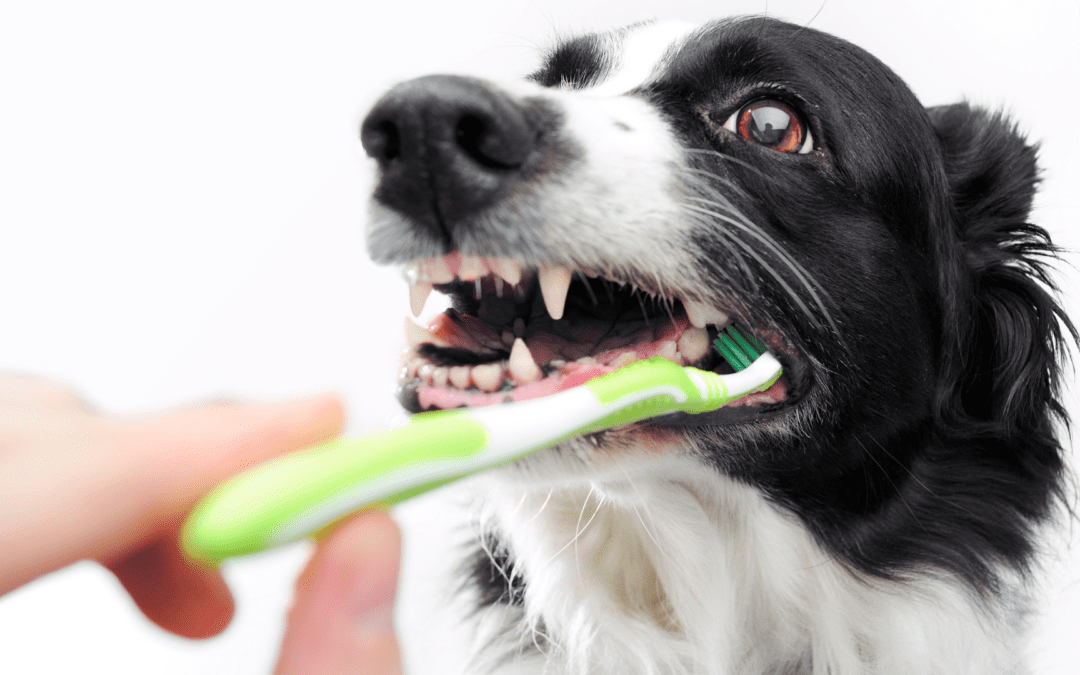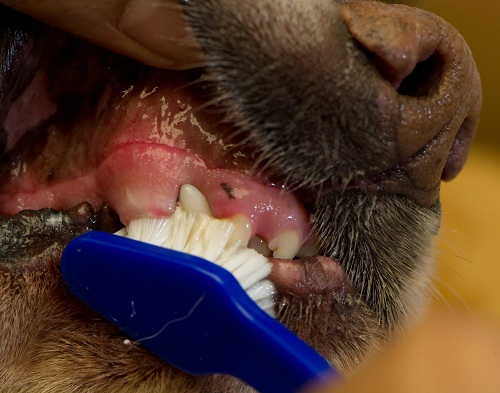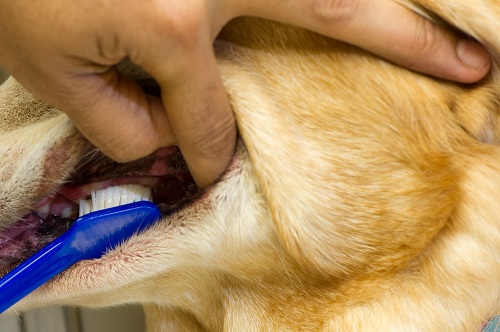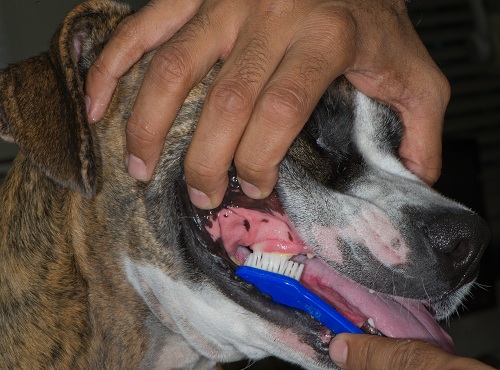Why should I brush my dog’s teeth?
It is estimated that over 2/3 of dogs over the age of three have periodontal disease, an inflammation or infection of the tissues surrounding the teeth. Periodontal disease starts as gingivitis caused by plaque and often progresses to involve the bony tooth sockets. Left untreated, periodontal disease can lead to painful tooth loss.
When should I brush my dog’s teeth?
Like us, it is ideal to brush your dog’s teeth at least twice daily. For many dogs, once brushing becomes a part of their daily routine they will begin to expect and enjoy it. Brushing three times a week is the minimum recommendation to help remove plaque and prevent tartar accumulation.
“It is best to teach your dog to accept tooth brushing while he is still a puppy.”
It is best to teach your dog to accept tooth brushing while he is still a puppy. If you have an older dog, the training process may take a little longer, but it is still well worth the effort.
What steps do I need to follow to teach my dog to accept tooth brushing?
In order to be successful at brushing your dog’s teeth, you must make it a positive experience for both of you. Make the experience positive by praising your dog throughout the whole procedure, with reassurance through every step. For best results, follow these steps:
- Choose a quiet time and place to begin.
- If your dog is small enough, hold your dog securely in your lap with his head facing away from you. If your dog is larger, you should sit on a chair and have your dog sit beside you so that you can comfortably handle his mouth and teeth.
- Start by rubbing your finger or a soft cloth over the outer surfaces of your dog’s teeth, using a back-and-forth motion – focusing on the area where the gum touches the tooth surface. Be careful to stay on the outside surfaces of the teeth to avoid being accidentally bitten. For the first few lessons, it is a good idea to rub the cloth along only a few teeth rather than the whole mouth, especially if your pet is unsure or nervous about the process.
- Once your dog is comfortable with you rubbing his teeth, let him taste a little bit of pet toothpaste from your finger. Do not use human toothpaste – it is not formulated to be swallowed.
- Once your dog has accepted the taste of pet toothpaste, apply a small amount to the cloth and rub it over the teeth.
- Once your dog is completely used to you rubbing his teeth with a cloth, it’s time to start using a toothbrush (see below).
What type of toothbrush should I use?
Commercial toothbrushes are available that are specifically designed for use in dogs. These include:
- brushes with angled handles,
- brushes with multiple heads (so that you can simultaneously brush the inside, outside, and top surfaces of the tooth),
- small brushes that fit comfortably in your hand, and
- finger toothbrushes (designed to fit over the tip of your finger).
For some dogs, it is acceptable to use a very soft toothbrush designed for use in human babies.
The type of toothbrush you use depends a little on the size of your dog and a little on your own dexterity. Many pet owners find it easier to use a finger brush, especially when just beginning to brush their dog’s teeth. Check with your veterinarian if you are uncertain of which brush to use.
Regardless of the type of toothbrush you use, it is important to be gentle and go slowly as it is easy to accidentally poke the tip of the toothbrush against the gums and cause some irritation.
Is it okay to use human toothpaste?
No. Human toothpastes contain ingredients that should not be swallowed. If it is swallowed, it can cause an upset stomach or digestive disturbances. Some human toothpastes contain high levels of sodium which may even make your pet ill, while others may contain xylitol which is toxic for dogs.
My friend recommended that I use baking soda. Is this okay?
No. Baking soda has a high alkaline content and, if swallowed, it can upset the acid balance in the stomach and digestive tract. In addition, baking soda does not taste good which may cause your dog to be uncooperative when you try to brush his teeth.
Why is pet toothpaste recommended?
Pet toothpaste is available in a number of different flavors that are appetizing to dogs, including poultry, beef, malt and mint. By using a product that tastes good, your dog will be more likely to enjoy the whole experience.
Exactly how should I brush my dog’s teeth?
Apply a small amount of toothpaste to the toothbrush. Gently raise your dog’s lips on one side of his mouth. You can either do this by pushing up on the lip with the index finger of your free hand (as shown in the image) or by placing your free hand over your dog’s head with your thumb and index finger on opposite sides of your dog’s upper jaw to lift his lips.

To brush the lower teeth, you will need to open your dog’s mouth a little. This can be done by gently tilting your dog’s head backward while holding onto his or her upper jaw with the thumb and index finger of your free hand.
At first, concentrate on brushing the large cheek teeth and the canine teeth, the teeth where plaque and tartar accumulate most quickly. Gradually work up to brushing all of the teeth (this will probably take several days or weeks).
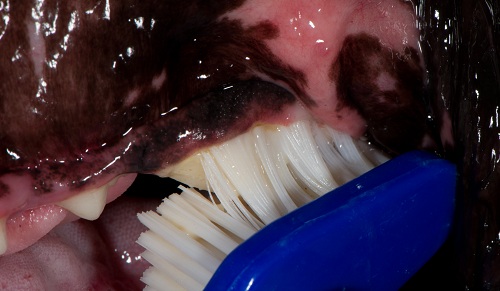
Do not worry about brushing the tips or insides of the teeth unless your dog is very cooperative. Most periodontal damage occur on the outer surfaces of the teeth and this is where you should direct your efforts. In addition, the dog’s tongue tends to remove a lot of the plaque from the inner surfaces of the teeth, reducing the need for brushing these surfaces.
How long should I spend brushing my dog’s teeth?
Try to brush for approximately 30 seconds per side.
What else can I do to maintain my dog’s dental health?
It is important to maintain your dog’s dental health. Plaque is an accumulation of bacteria and is a sticky substance that begins to accumulate on the teeth within hours after a meal or even after a professional tooth cleaning. Within a day, plaque combines with minerals that are present in the saliva to become tartar, also known as calculus. A list of dental products and diets that have been accepted by the Veterinary Oral Health Counsel can be found at vohc.org. These accepted products have been shown to decrease the accumulation of plaque and/or tartar by at least 20%.
Is there anything else I should know?
Yes. A dog’s mouth contains lots of bacteria, if possible, wear gloves while brushing your dog’s teeth. If this limits your ability to effectively brush his teeth, then be sure to thoroughly wash your hands with soap and water after you are finished. Also, rinse the toothbrush thoroughly before putting it away. Replace the toothbrush every three months and if you have several dogs, use a different toothbrush for each of them.
© Copyright 2020 LifeLearn Inc. Used and/or modified with permission under license.

